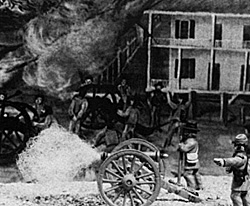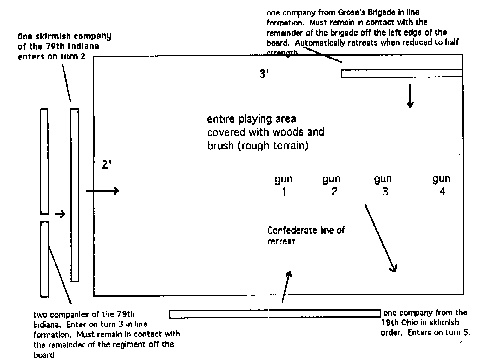

The Battle of Chickamauga was the largest western theater battle in the American Civil War. The Union Army of the Cumberland and the Confederate Army of Tennessee fought the battle in the densely wooded terrain just south of Chattanooga. The two-day fight resulted in a costly but spectacular Confederate tactical victory. The first day of the fight was a confused meeting engagement with both sides conducting attacks and counterattacks along a four-mile front.
This scenario represents a very small part of the first day of the battle. It deals specifically with the actions of one Confederate battery in Cheatham's Division. Cheatham's Division entered the right about mid-day in a desperate attempt to stabilize the Confederate left flank. Cheatham's Confederates were successful at first in pushing back Palmer's Union Division, but were soon forced to give ground when Van Cleve's Union Division attacked on their left flank,.
Captain William W. Carnes' Confederate battery supported Wright's Brigade in Cheatham's Division. Initially, he had trouble getting his guns into the fight. Carnes dismounted his cannoneers to chop brush and clear a path for the guns. He then positioned his battery on the left flank of Wright's Brigade. The guns went into action just in time to beat off an attack by Grose's Union Brigade of Palmer's Division.
Carnes then had to shift his attention to his left flank. Skirmishers from the 79th Indiana (Beatty's Brigade of Van Cleaves Division) had worked up to within a hundred yards of the battery's flank. Carnes' unit started taking heavy casualties almost immediately. Double canister fire from the battery kept the 79th Indiana back, but the 19th Ohio was able to move into a position behind the battery.
".. .In the heavy fighting which immediately followed, many of the men and horses were soon killed or diasbled; and Carnes, seeing the impossibility of saving his guns if our line should be pressed back, sent his orderly to report the situation to the division commander and ask for help. Receiving reply to hold his ground as long as possible, Carnes dismounted his officers and sergeants and put them on the guns to replace the cannoneers as they were shot down, and, giving the enemy double charges of canister at close range, drove back the line in his front; but as he had no support on his left, the federals swung around the battery until it was almost surrounded.
Finding it impossible to hold out longer, Carnes sent his few surviving men to the rear and, with his sergeant, fired the left gun a few times as rapidly as possible to keep back the fast closing lines, and then he and his sergeant jumped to their horses, which were tied near by. The sergeant mounting first, was riddled with bullets from a volley that passed over the Captain as he was in the act of mounting, wounding his horse. Making a dash for the narrow opening to the rear, Capt. Carnes escaped capture by being well mounted and a good rider.
His horse was struck a number of times, and could barely carry his rider till he reached the support coming from the rear, and fell just after he passed through the advancing Confederate line."- T. L. Massenburg, Capt. W. W. Carnes Battery at Chickamauga, Confederate Veteran 6, (November 1898): 518.
Carnes' battery lost all four of its guns (two 6-pounder smooth bores and two 12-pounder howitzers). He also lost one officer and eighteen men killed, eighteen men wounded, and one man captured from an assigned strength of seventy-eight officers and men. Only ten of the battery's fifty-nine horses survived the fight.
ADAPTING THE SWORD AND THE FLAME
Actually, there are very few changes required to adapt The Sword And The Flame (TSATF) to this American Civil War battery action.
ORGANIZATION
Do not worry about rebasing all your Civil War figures for this small scenario; my units are based for Fire and Fury. The game works well by just using appropriate markers.
- Union units should be organized as standard 20 figure infantry units. Each unit will notionally represent a Civil War infantry company.
- Organize Cames' Battery with four guns (2 6-pounder smooth bores and 2 12-pounder Howitzers). Each gun should have the standard 4 man TSATF crew (a sergeant and 3 crew members). Each two gun section should have a mounted lieutenant (a dismounted replacement is also needed). Lt. Massenburg commanded the left section (Howitzers) and Lt. Van Vleck the right section (6-pound er smoothbores). A mounted and dismounted figure will also be needed for Capt. Cames. Each gun also needs a limber with four horses and a driver.
MOVEMENT
- Movement is basically the same as for standard TSATF. A gun with its limber represents a basic unit for drawing movement cards. The two line companies of the 79th Indiana move as one unit.
- Artillery move is changed to four dice for cross-country. This gives the limber one movement dice for each of its four horses.
- The entire scenario takes place in rough terrain (make the appropriate movement penalties).
- Reduce limber movement by one dice for each horse lost. If the limber is reduced to one horse, then half the movement for rough terrain.
- It takes one full tum with a minimum of 2 crew figures to limber a gun. Example: On tum one the gun and limber are moved together. On turn two the gun is attached to the limber. On turn three the gun and limber may conduct normal movement.
- A limber cannot move if it has a dead or wounded horse attached to the limber. A gun crew figure of driver must give up one of its movement dice to cut away a dead or wounded horse from the limber. A limber that moves on the same turn a dead horse is but away loses one die or the head horse and one die for the act of cutting away the dead horse.
- A figure must remain with the limber of the horses will automatically rout if they or a nearby unit is fired upon. A dead horse will hold the limber in place without a gun crew figure holding the limber.
FIRING
- Firing is conducted the same as in TSATF. Each gun with its crew counts as a basic unit for firing. Each crew figure (maximum of 4) counts as 3 with the 12-pound howitzers (this is standard artillery fire for TSATF) and as 2 with the 6-pound guns (to reflect the difference between 12 and 6 pound canister. The two line companies of the 79th Indiana draw separate cards for firing.
- Infantry skirmishers and gun crews count as Class III targets.
- Infantry in line formation count as Class II targets (a mass formation in rough terrain).
- Key figure cards count as horses in the target area. Example: An infantry company in skirmish order fires at the left most gun and achieves four hits. A two of Spades, a three of Hearts, a Jack of Diamonds, and a Queen of Hearts. This results in one crewman wounded, one dead plus one horse wounded and one dead.
- Because of the large number of leaders in the Confederate battery, always make a separate die roll to determine which leader is hit when an Ace is drawn. Example: The left most gun has 3 leaders in the target area. The gun crew takes casualties which includes one Ace card. Assign a red dice to Cpt. Carnes, a white die to Lt. Massenburg, and a green die for the sergeant. The high die is the casualty.
- Rifle range is halved clue to the rough terrain.
- Artillery range is not affected by the rough terrain.
- Officer pistols have a range of 6", a die of 6 equals two hits, a die of 5 equals one hit. Any other result is a miss.
MELEE & OTHER CHARTS
- Melee is conducted as in TSATF.
- Union skirmish companies cannot engage in melee.
- On all charts refer to the Confederates as British and the Federals as Egyptians. No changes to the other charges other than those mentioned above.
THE SCENARIO

Federal Forces:
- 1 skirmish company of the 36th Ind. (Grose's Bde)
1 skirmish company of the 70th Ind. (Beatty's Bde)
2 Line companies of the 79th Ind. (Beatty's Bde)
1 skirmish company of the 19th Oh (Beatty's Bde)
Confederate Forces:
- Carnes' Tenn. Battery
Victory Conditions:
Federal Capture at least 3 of Carnes' guns.
Confederate Save at least 2 of Carnes' guns. Carnes may not begin withdrawing his guns until the beginning of turn 2.
BIBLIOGRAPHY
Cozzens, Peter, This Terrible Sound: The Battle of Chickamauga; University of Illinois Press, Chicago, 1992.
Robertson, Glen, Staff Ride Handbook for the Battle of Chickamauga; Combat
Studies Institute, U.S. Army Command and General Staff College, Fort Leavenworth,
Kansas, 1992.
The War of the Rebellion: A Compilation of the Official Records. Washington: U.S. Government Printing Office, 1880-1901
Massenburg, T.L. "Capt. W. W. Carnes' Battery at Chickamauga", Confederate
Veteran 6 [November 1898] 518.
Back to Table of Contents -- Courier #69
© Copyright 1996 by The Courier Publishing Company.
This article appears in MagWeb (Magazine Web) on the Internet World Wide Web.
Other military history articles and gaming articles are available at http://www.magweb.com